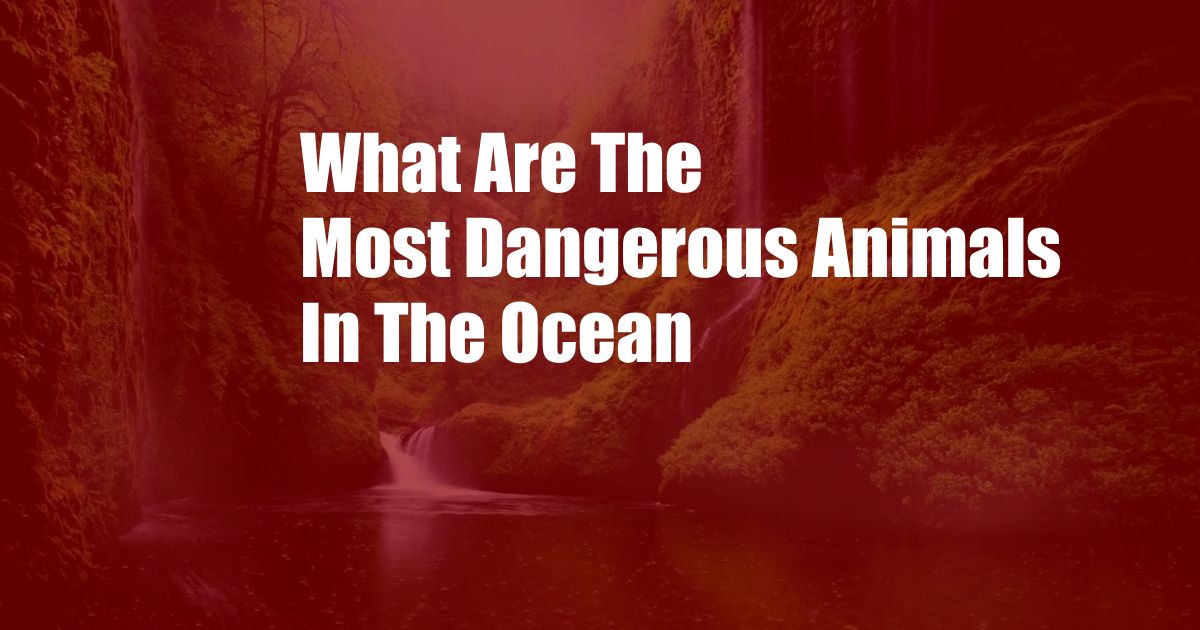
The Most Dangerous Denizens of the Deep: Unveiling the Perils of the Ocean
The Ocean’s Allure and Treachery:
As humans, we’re naturally drawn to the vast and enigmatic ocean. Its crystal-clear waters and vibrant marine life leave us in awe. Yet, beneath this serene facade lurks a realm of danger, where creatures with formidable defenses and predatory instincts reside. Embarking on a journey through the ocean’s depths, we uncover the most dangerous animals that call this watery expanse their home.
Sharks: Apex Predators of the Sea
Epitomizing the ocean’s formidable presence, sharks reign supreme as the apex predators. With over 500 species inhabiting various marine environments, they exhibit diverse hunting strategies and powerful jaws. Great white sharks, with their iconic conical teeth and relentless pursuit, are among the most feared. Tiger sharks, known for their aggressive behavior and broad diet, pose another significant threat.
Jellyfish: Invisible Stingers of the Deep
Jellyfish, with their ethereal, transparent bodies, often lull us into a false sense of security. Their graceful movements belie the potent venom they carry. Box jellyfish, found in the warm waters of Australia and the Pacific, deliver a lethal sting capable of causing cardiac arrest and respiratory failure within minutes. Bluebottles, common along coastal areas, have long trailing tentacles that can inflict intense pain.
Cone Snails: Venomous and Lethal
Unlike ordinary snails, cone snails conceal a deadly secret within their vibrant shells. Armed with a specialized venom gland, they inject a cocktail of neurotoxins capable of paralyzing prey. The geographic cone snail, found in the Indo-Pacific region, is particularly notorious for its potent venom, which can be fatal to humans.
Stonefish: Masters of Camouflage
Lurking on the ocean floor, stonefish embody the epitome of camouflage. Their uncanny resemblance to rocks makes them incredibly difficult to detect. Hidden amidst coral reefs, their dorsal fins carry venom-filled spines. A single sting can cause excruciating pain, tissue necrosis, and even respiratory failure.
Blue-Ringed Octopus: Tiny but Terrifying
Measuring just a few centimeters in size, blue-ringed octopuses possess a venomous bite that belies their unassuming appearance. These cephalopods carry a neurotoxin that paralyzes the nervous system, leading to muscle weakness and potential respiratory failure. Their vivid blue rings serve as a warning signal, making them instantly recognizable and a threat to avoid.
Trends and Developments: Exploring the Evolving Dangers
As marine ecosystems undergo constant change, so too must our understanding of the perils they hold. Climate change, overfishing, and pollution impact the behavior and distribution of dangerous marine animals. The increasing frequency of shark attacks in certain regions raises concerns, while the spread of invasive jellyfish species poses新たな challenges.
Tips for Navigating the Perils of the Ocean
While respecting the ocean’s power and its dangerous inhabitants is crucial, it doesn’t mean we should avoid exploring its wonders. By following these tips, you can enhance your safety and minimize risks:
- Swim in designated areas: Designated beaches and swimming spots are usually monitored for marine hazards, providing a safer environment.
- Avoid murky waters: Poor visibility makes it difficult to spot dangerous creatures, so it’s best to avoid swimming in cloudy or murky areas.
- Be aware of your surroundings: Stay alert and observe your surroundings before jumping into the water. Look out for fins, tentacles, or any unusual activity.
- Wear protective gear: Wetsuits and diving gear can provide some protection against stings or bites.
- Don’t provoke wildlife: Never attempt to touch or interact with marine animals. Maintain a respectful distance and admire their beauty from afar.
Frequently Asked Questions (FAQs): Addressing Common Concerns
Q: Are sharks really as dangerous as they’re portrayed?
A: While sharks have a reputation as fearsome predators, they’re generally not aggressive towards humans. Most shark attacks are provoked or occur when sharks mistake humans for prey.
Q: How can I tell the difference between a jellyfish and a Portuguese man o’ war?
A: Portuguese man o’ wars, despite their jellyfish-like appearance, are actually colonial organisms. They possess a sail-like structure that floats above the water, while jellyfish have umbrella-shaped bodies that pulsate.
Q: Are stonefish common in all oceans?
A: Stonefish are primarily found in the tropical and subtropical waters of the Indo-Pacific region, including Australia, Southeast Asia, and the Red Sea.
Conclusion: Embracing the Ocean’s Wonders While Respecting Its Perils
The ocean’s captivating beauty is undeniable, but it’s essential to remember that it’s also a realm of potential danger. By gaining knowledge about the most dangerous marine animals, understanding their behaviors, and following safety guidelines, we can navigate the ocean’s depths with both appreciation and respect.
So, are you ready to dive into the unknown and explore the ocean’s dangerous wonders? Remember, knowledge is power, and staying informed is the key to a safe and unforgettable marine adventure.